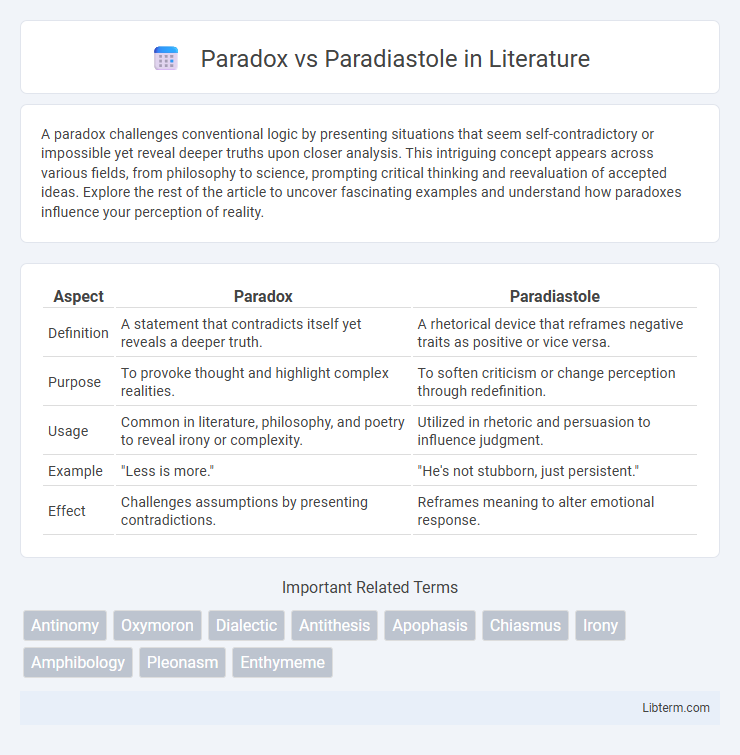A paradox challenges conventional logic by presenting situations that seem self-contradictory or impossible yet reveal deeper truths upon closer analysis. This intriguing concept appears across various fields, from philosophy to science, prompting critical thinking and reevaluation of accepted ideas. Explore the rest of the article to uncover fascinating examples and understand how paradoxes influence your perception of reality.
Table of Comparison
| Aspect | Paradox | Paradiastole |
|---|---|---|
| Definition | A statement that contradicts itself yet reveals a deeper truth. | A rhetorical device that reframes negative traits as positive or vice versa. |
| Purpose | To provoke thought and highlight complex realities. | To soften criticism or change perception through redefinition. |
| Usage | Common in literature, philosophy, and poetry to reveal irony or complexity. | Utilized in rhetoric and persuasion to influence judgment. |
| Example | "Less is more." | "He's not stubborn, just persistent." |
| Effect | Challenges assumptions by presenting contradictions. | Reframes meaning to alter emotional response. |
Defining Paradox and Paradiastole
Paradox is a statement or proposition that contradicts itself or defies intuition, revealing a hidden truth through apparent inconsistency. Paradiastole, in rhetoric, refers to the reframing of a negative trait or concept by redefining it with euphemistic or positive language to alter perception. Understanding paradox involves recognizing contradictory elements that coexist, while paradiastole emphasizes the power of language to reshape moral or emotional judgment.
Historical Origins and Development
Paradox traces its origins to ancient Greek philosophy, particularly Aristotle's explorations of contradictory statements that defy conventional wisdom to provoke deep reflection. Paradiastole, emerging from classical rhetoric, specifically denotes the reframing of negative traits into positive ones, a technique employed by ancient orators to soften criticism and persuade audiences. Over centuries, paradox evolved into a fundamental literary and philosophical device, while paradiastole remained a specialized rhetorical strategy for ethical valuation and characterization.
Key Characteristics of Paradox
Paradox is a rhetorical device that presents a statement that appears self-contradictory or logically impossible but reveals a deeper truth upon reflection. It often challenges conventional beliefs by juxtaposing opposing ideas, creating cognitive tension that prompts reevaluation of assumptions. Key characteristics include its apparent contradiction, the underlying meaning that defies surface-level logic, and its use in literature and philosophy to provoke insight and emphasize complex realities.
Key Characteristics of Paradiastole
Paradiastole is a rhetorical device that redefines the negative aspects of a concept by using euphemistic or positive language to soften or alter perception, distinguishing it from paradox which presents contradictory ideas for effect. Key characteristics of paradiastole include its function to recast moral or undesirable traits as virtues, its use in persuasive speech to influence audience interpretation, and its reliance on positive re-description rather than logical contradiction. This technique often serves to mitigate criticism or highlight complexity through nuanced language shifts.
Semantic Nuances: Contrast and Comparison
Paradox and paradiastole both involve semantic shifts but serve distinct rhetorical purposes: paradox presents a self-contradictory statement that reveals deeper truth, while paradiastole reinterprets negative qualities positively through euphemistic redefinition. The semantic nuance of paradox lies in its tension and surprise, challenging logical expectations, whereas paradiastole softens or reframes character traits to influence perception. Analyzing these devices highlights how semantic contrast or redirection shapes meaning and persuasion in language.
Paradox in Literature and Rhetoric
Paradox in literature and rhetoric serves as a powerful device that presents seemingly contradictory statements to reveal deeper truths or provoke thought, often challenging readers' expectations and encouraging critical reflection. It contrasts with paradiastole, which functions primarily to reframe a negative attribute into a positive light through euphemistic language. Examples like Shakespeare's "less is more" illustrate paradox's capacity to convey complex ideas through illogical yet meaningful expressions.
Paradiastole in Persuasion and Argument
Paradiastole, a rhetorical device emphasizing redefinition or reframing, plays a crucial role in persuasion by softening negative traits into positive ones, thus transforming criticism into praise and influencing audience perception. Unlike paradox, which highlights contradictory ideas to provoke thought or illustrate complexity, paradiastole strategically reframes moral or evaluative judgments to align with the speaker's argument, enhancing persuasive impact. Effective use of paradiastole can shift debates by redirecting negative connotations into virtues, strengthening argumentative appeals through nuanced semantic shifts.
Common Examples of Each Device
Paradox often appears in literary and philosophical contexts, exemplified by statements like "This statement is false," where contradiction challenges logical norms and provokes deeper thought. Paradiastole, on the other hand, involves reframing negative traits positively, as in calling stubbornness "determination" or laziness "restfulness," commonly found in persuasive speech and rhetoric. These devices differ in function; paradox confronts with conflicting logic, while paradiastole softly shifts perception by redefining attributes.
Impact on Reader Interpretation
Paradox creates tension by presenting contradictory statements that challenge the reader's expectations, prompting deeper reflection and highlighting complex truths. Paradiastole softens negative traits through euphemistic description, guiding the reader to interpret the subject more leniently or positively. These rhetorical devices shape reader interpretation by either provoking critical analysis with paradox or inducing empathetic understanding through paradiastole.
Choosing Between Paradox and Paradiastole
Choosing between paradox and paradiastole depends on the rhetorical goal: paradox presents an apparent contradiction that reveals a deeper truth, often engaging readers through surprise and critical thinking. Paradiastole reframes negative traits as positive or neutral, softening judgments to persuade or redefine perceptions without overt contradiction. Effective communication requires discerning when to challenge assumptions with paradox or to strategically mitigate criticism using paradiastole based on the desired impact and audience sensitivity.
Paradox Infographic

 libterm.com
libterm.com